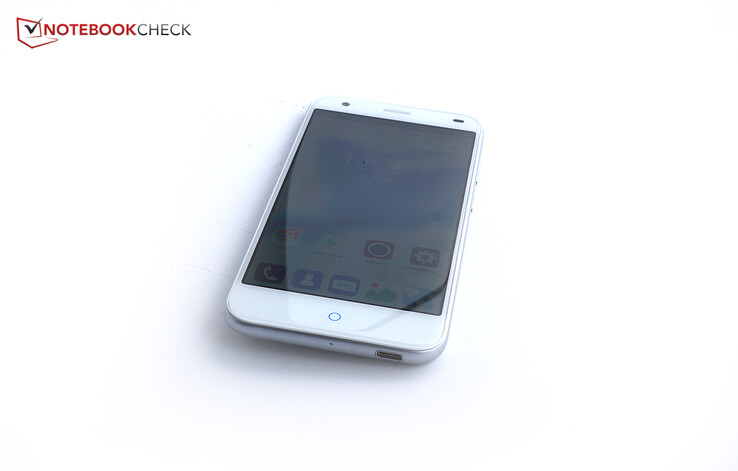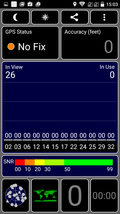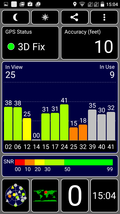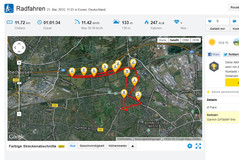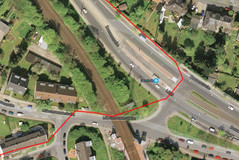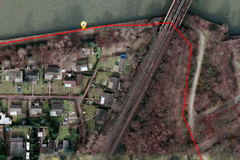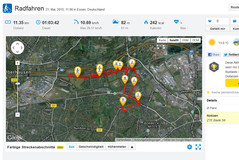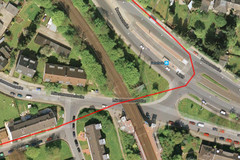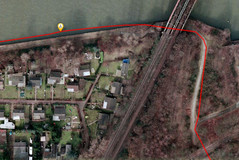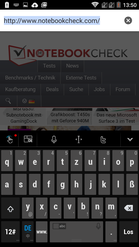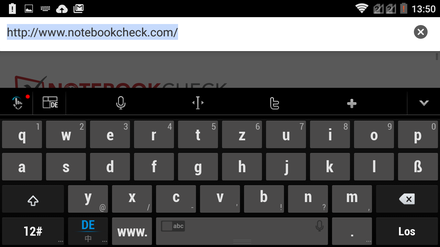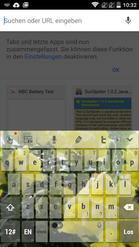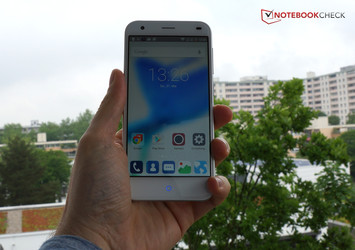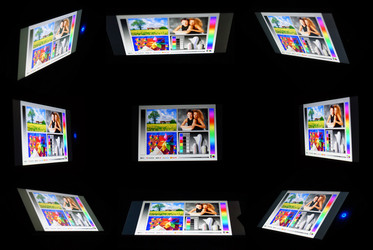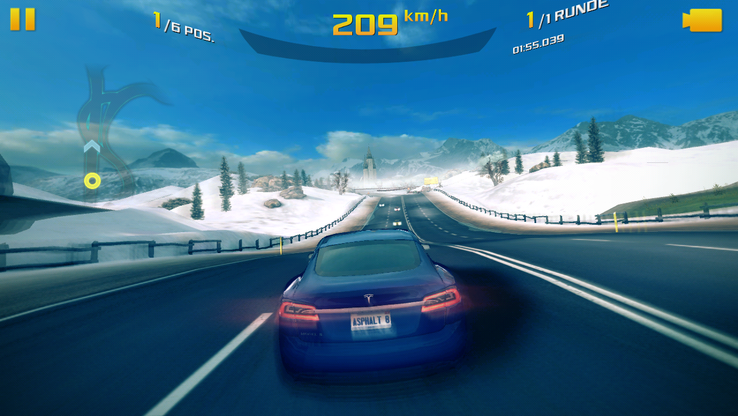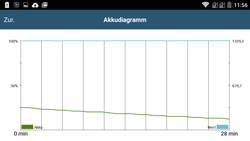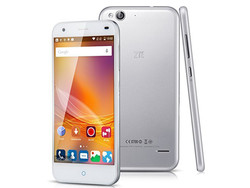ZTE Blade S6 Smartphone Review
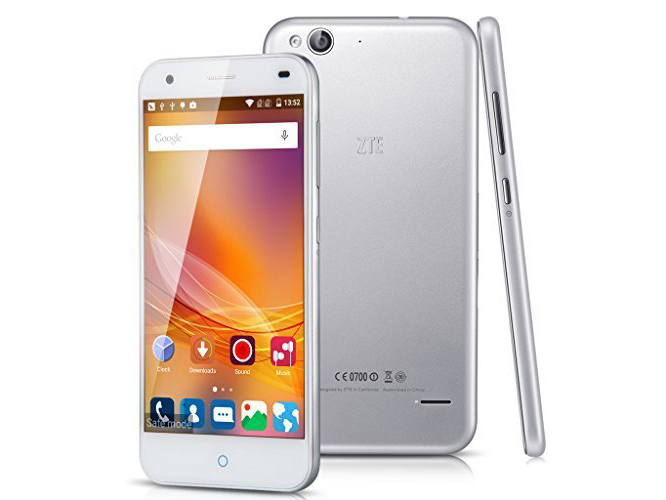
For the original German review, see here.
The Chinese manufacturer presents the advantages of its new ZTE Blade S6 mid-range smartphone in a video accompanied by music that sounds a bit like martial hard rock music. In addition to the powerful SoC, a camera sensor from Sony, extensive gesture controls, LTE and Android Lollipop are installed. That sounds very promising at first, especially since ZTE's Blade S6 is quite affordable at a recommended retail price of 259 Euros (~$287) and a street price of approximately 225 Euros (~$250).
However, there are plenty of high-performance contenders in this price range, such as the OnePlus One, Wiko Ridge 4G, LG Spirit 4G, Nokia Lumia 735 or Samsung Galaxy Grand Prime. LTE has now become standard here, and ZTE's Blade S6 can no longer stand out with that. We will see how it fares otherwise.
Case
ZTE describes its smartphone as "curved," and it even sometimes speaks of a "curved screen." That is a bit misleading. ZTE's Blade S6 is not a curved smartphone like LG's G Flex 2, and only the edges are rounded like in the latest iPhone 6. Talking about the iPhone 6: Not only the naming of ZTE's Blade S6 is quite obviously suggestive of Apple's smartphone, but the casing with its circular touch button below the screen as well as the rounded edges look a lot like the successful model from Cupertino.
ZTE also states a "unibody" casing, i.e. a chassis made of one piece. Although that is true, the buyer should not expect metal. The black or white front is only bordered by a shiny metallic plastic back.
The chassis makes a rigid impression but creaks quietly under pressure that becomes visible in the liquid crystals. The back cannot be removed, which is noted on a sticker on the back as a precaution.
ZTE's Blade S6 is certainly a slim smartphone with a casing thickness of 7.7 millimeters, and it is also fairly light at 134 grams. The rounded edges make it pleasant to hold, and the back also has enough grip to prevent the smartphone from slipping out of the hand.
Connectivity
A generous 2 GB of working memory is installed. However, that is no longer a special highlight in this price range. OnePlus' One even has 3 GB. In contrast, the 16 GB of storage capacity seems a bit meager; 12 GB of that can be used. Furthermore, the microSD slot supports a maximum of 32 GB. At least apps can be moved to the SD card. The SoC makes a powerful impression for this price range, and the camera equipment is also promising at a first glance.
Software
The operating system is based on Google's Android version 5.0. ZTE covers it with its self-developed user interface Mifavor UI 3.0. However, only minor modifications have been made. Some icons have changed, and it is possible to change wallpaper and color scheme directly on the home screen. The user can even add a blur effect to the background and the transition effects can be defined.
Some software has been preloaded but not all of it makes sense. For example, "Mi-POP" is a menu that can be pulled out from the side and placed anywhere on the screen. However, it would be more useful on smartphones that fade in a menu bar at the screen's lower edge and thus reduce its size since it contains home, menu and back buttons. These are implemented as touch buttons below the screen in ZTE's Blade S6. "AliveShare" makes data sharing with others via Wi-Fi possible. Navigation software, an office suite, a backup manager, file manager, and the messenger "Chaatz" are also preloaded. However, none of that is something that cannot be found in Google's Play Store for free.
Communication & GPS
The wireless module in ZTE's Blade S6 supports mobile networks in GPRS, UMTS and LTE standards in multiple networks. GPRS and UMTS networks are available via four different frequencies, and it is even five in LTE. The reception in the mobile network is decent. We always had a good signal in the German o2/E-Plus networks inside and outside of the building in an urban area.
The SIM-card tray looks as if it would hold a full-sized SIM when pulled out from the casing with the tool. However, it is actually two slots for nano-SIM cards; the Blade S6 supports dual-SIM. Its implementation in Android 5 has also been solved nicely. The SIMs can be enabled and disabled singly in the menu, and it is possible to determine a card for mobile data. It is also possible to assign calls to a SIM or decide for every call per se. Note: Only the first SIM slot supports LTE or UMTS; the second is limited to GSM.
Support for high-speed Wi-Fi networks in standard 802.11ac is desired? ZTE's Blade S6 can offer that. It is also possible to select between the 2.4 GHz and 5 GHz bands. The reception was rather middling at a distance of ten meters and through three walls from the router. We only had half the signal strength, but websites still opened quickly.
The GPS module could not locate us indoors. However, the smartphone is found quickly outdoors, and it is also very accurate with a deviation of three meters. Many users have reported GPS issues on the Internet, but localization functioned well with our review sample.
We took ZTE's Blade S6 along on a bike ride, and the Garmin GPSMAP 64s was used for comparison. Generally, the Blade S6 recorded a 400-meter shorter route than Garmin's navigation system, which is a clear difference. Neither device really placed us accurately on the street at a railway crossing. However, the Blade S6 had the longer interruption before relocating the position again.
The Blade S6 started tracking us through the woods and along the riverside accurately. However, it did not see us on the boardwalk after a while, but in the river. Users should not rely on the smartphone too much should a really accurate navigation be expected. It is nevertheless sufficient for everyday use.
Telephone & Voice Quality
The phone app can be opened directly from the lock screen. It is too bad that the app itself is in English even when German has been selected. The user is first directed to a speed-dial tab that contains favorites and frequently called contacts. The seamless integration of apps, such as Skype, has been well-implemented. It is thus possible to start a video call via Skype directly from the contacts tab. The keypad is always available via a round button at the screen's lower edge.
The voice quality is decent. Our contact sounded loud and clear. The maximum volume of the earpiece is also high but produces a light hum then. The microphone also functions well. Our contact heard us loud and clear; only the noise suppression could occasionally take more effect.
Cameras & Multimedia
A look at the spec sheet of ZTE's Blade S6 under the "Camera" section reminds us of OnePlus' One. A 13-megapixel camera from Sony with the option of recording UHD videos is also on the rear of ZTE's smartphone. However, in contrast to OnePlus' One, it only has a simple LED flash. The specs are also identical for the front: A 5-megapixel camera is for shooting decent selfies here.
The pictures of the primary camera are very good in bright light, and the exposure has been selected well. The colors look vivid but perhaps a bit oversaturated. That is, however, a matter of taste; we liked the rich colors. The focus clearly diminishes toward the image's edges. The low-light reproduction is still decent, but the pictures soon look quite muddy in blowups. Pictures are only taken in 9 megapixels in the camera app's default settings; 13 megapixels has to be selected separately. The pictures of the front-facing camera are satisfactory, but the sharpness is not always ideal. The color reproduction is good, though. Bright surfaces tend to look overexposed.
It would theoretically be possible to record 4K videos with the rear-facing camera, but the smartphone does not support this. The camera also only supports 30 frames per second when recording videos in Full HD, which leads to jerkiness in very fast movements. The image quality of the videos is overall acceptable.
ZTE has added a few features to the camera app. The expert mode fades in a bubble level for taking straight pictures, and where ISO rates or white balance can be set manually. It is also possible to enable face detection.
Accessories
ZTE ships the Blade S6 with a charger, a micro-USB cable and an eject tool for the card trays on the smartphone's side. Although there is an option for detecting a leather cover with a window in the menu, we could not find such a cover from ZTE either on ZTE's website or on the Internet. However, accessory manufacturers have reacted and offer a multitude of covers.
Warranty
Although no warranty information is found in the box, ZTE has deposited a general document on its German website which promises a 24-month warranty on all smartphones.
Input Devices & Handling
ZTE preloads the keyboard app "Touch Pal X." It offers a multitude of settings - starting with the size of word suggestions over the vibration period during typing up to a custom keyboard background; almost everything can be configured. Additionally, there is a convenient quick-access bar above the keyboard with links to, for example, edit mode for simply deleting, copying or inserting parts of a text. The keyboard supports voice and swipe inputting and has relatively big keys in the default settings. We found the double-assignment of the keys with symbols and numbers a bit unclear; there is no dedicated number row.
However, we found some things annoying: We first had to download a setting for the German keyboard layout, which involved quite a lot of clicking. Word suggestions are implemented by tapping the space bar, which often led to unintentional, erroneous entries. It is possible to use Google's stock keyboard should the user dislike the keyboard despite its multiple features. However, the user will continuously receive notifications from "Touch Pal X" until this app is uninstalled.
Three touch buttons for home, menu and back are found below the screen. They can be remapped, but the buttons are not labeled so that the user will have to often think about on which side the back button was in the beginning.
The touchscreen does not give reason for complaint. It responds quickly and reliably to inputs up to the outermost edge.
ZTE additionally adds multiple gestures that allow controlling the phone. The camera is automatically enabled when the smartphone is held in landscape mode and lifted while in standby. The music player can be turned on and off via a "V" gesture in the air, and when it is shook in standby mode the flashlight is turned on. The gestures function well, but the device is sometimes shaken unintentionally.
Display
The screen in ZTE's Blade S6 is category average with 1280x720 pixels. The maximum average brightness of 377.4 cd/m² is on a decent level. However, it is surpassed by, for example Wiko's Ridge 4G or Samsung's Galaxy Grand Prime. A homogeneous illumination of 90% lets large colored areas look quite solid.
| |||||||||||||||||||||||||
Brightness Distribution: 90 %
Center on Battery: 386 cd/m²
Contrast: 877:1 (Black: 0.44 cd/m²)
ΔE Color 7.12 | 0.5-29.43 Ø5
ΔE Greyscale 6.7 | 0.57-98 Ø5.3
Gamma: 1.98
| ZTE Blade S6 Adreno 405, 615 MSM8939, 16 GB eMMC Flash | OnePlus One Adreno 330, 801 MSM8974AC, 64 GB eMMC Flash | Nokia Lumia 735 Adreno 305, 400 MSM8926, 8 GB eMMC Flash | LG Spirit Adreno 306, 410 MSM8916, 8 GB eMMC Flash | Wiko Ridge 4G Adreno 306, 410 MSM8916, 16 GB iNAND Flash | Samsung Galaxy Grand Prime Adreno 306, 410 MSM8916, 8 GB eMMC Flash | |
|---|---|---|---|---|---|---|
| Screen | -2% | 11% | 2% | 1% | -12% | |
| Brightness middle | 386 | 423 10% | 291 -25% | 359 -7% | 459 19% | 426 10% |
| Brightness | 377 | 408 8% | 293 -22% | 348 -8% | 434 15% | 415 10% |
| Brightness Distribution | 90 | 83 -8% | 93 3% | 92 2% | 90 0% | 90 0% |
| Black Level * | 0.44 | 0.54 -23% | 0.46 -5% | 0.35 20% | 0.83 -89% | |
| Contrast | 877 | 783 -11% | 780 -11% | 1311 49% | 513 -42% | |
| Colorchecker dE 2000 * | 7.12 | 5.56 22% | 4.04 43% | 5.17 27% | 9.69 -36% | 5.98 16% |
| Greyscale dE 2000 * | 6.7 | 7.55 -13% | 2.87 57% | 5.4 19% | 10.8 -61% | 6.03 10% |
| Gamma | 1.98 111% | 2.33 94% | 2.49 88% | 2.35 94% | 1.82 121% | 2.48 89% |
| CCT | 7784 84% | 7624 85% | 6432 101% | 7168 91% | 9063 72% | 7983 81% |
* ... smaller is better
The black level of 0.44 cd/m² is agreeably low; black areas still look very dark even in high brightness levels. That also leads to a very good contrast ratio of 877:1, and colors look quite vivid on the screen.
A more detailed analysis of the color reproduction is achieved using the software CalMAN in conjunction with a spectrophotometer. We discovered, in line with an increased color temperature, a minor bluish cast that is visible in the bright grayscale levels, and which shifts slightly into magenta. Almost all color hues are oversaturated, which contributes to the lively color impression that we subjectively noticed. The shifts in the color and grayscale rates compared with the sRGB reference color space are quite big. Thus, professional image editors should not rely on the screen's reproduction.
Outdoor use is quite possible on cloudy days despite the screen's highly reflective surface. However, reflections strain the eyes in sunlight. It is usually no problem to recognize content indoors.
Performance
Our review sample sports Qualcomm's Snapdragon 615 MSM8939 SoC, which has eight cores that clock at 1.7 GHz. However, not too much should be expected from the eight cores because not many apps can utilize this power, and only four of the cores clock at full speed. The other four clock at 1 GHz. That should at least help save energy since the faster cores are disabled during less demanding tasks. Our experience shows that the Snapdragon 615 MSM8939 is located in the upper mid-field, and the SoC should actually be strong enough for all present day apps. Navigating in the menus is smooth in any event.
ZTE's Blade S6 can certainly boast with more performance in relation to the comparison devices; only OnePlus' One offers more power.
| Geekbench 3 | |
| 64 Bit Single-Core Score (sort by value) | |
| ZTE Blade S6 | |
| LG Spirit | |
| 64 Bit Multi-Core Score (sort by value) | |
| ZTE Blade S6 | |
| LG Spirit | |
| Smartbench 2012 | |
| Productivity Index (sort by value) | |
| ZTE Blade S6 | |
| OnePlus One | |
| LG Spirit | |
| Gaming Index (sort by value) | |
| ZTE Blade S6 | |
| OnePlus One | |
| LG Spirit | |
| AnTuTu v5 - Total Score (sort by value) | |
| ZTE Blade S6 | |
| OnePlus One | |
| LG Spirit | |
The 16 GB of internal storage in ZTE's Blade S6 is not exactly swift. Most other comparison devices offer considerably higher speeds. Once again, OnePlus' One primarily stands out here. Write rates are the talent of the storage device in our review sample. The rates are considerably more competitive than in read accessing.
| AndroBench 3-5 | |
| Sequential Read 256KB (sort by value) | |
| ZTE Blade S6 | |
| OnePlus One | |
| Samsung Galaxy Grand Prime | |
| Wiko Ridge 4G | |
| LG Spirit | |
| Sequential Write 256KB (sort by value) | |
| ZTE Blade S6 | |
| OnePlus One | |
| Samsung Galaxy Grand Prime | |
| Wiko Ridge 4G | |
| LG Spirit | |
| Random Read 4KB (sort by value) | |
| ZTE Blade S6 | |
| OnePlus One | |
| Samsung Galaxy Grand Prime | |
| Wiko Ridge 4G | |
| LG Spirit | |
| Random Write 4KB (sort by value) | |
| ZTE Blade S6 | |
| OnePlus One | |
| Samsung Galaxy Grand Prime | |
| Wiko Ridge 4G | |
| LG Spirit | |
Our review sample scored very well in Internet accessing, where the browser speeds were very high. That becomes apparent in smooth animations and swift website loading. Very good!
| Sunspider - 1.0 Total Score (sort by value) | |
| ZTE Blade S6 | |
| OnePlus One | |
| Nokia Lumia 735 | |
| Samsung Galaxy Grand Prime | |
| Wiko Ridge 4G | |
| LG Spirit | |
| Octane V2 - Total Score (sort by value) | |
| ZTE Blade S6 | |
| Nokia Lumia 735 | |
| Samsung Galaxy Grand Prime | |
| Wiko Ridge 4G | |
| LG Spirit | |
| Mozilla Kraken 1.1 - Total (sort by value) | |
| ZTE Blade S6 | |
| OnePlus One | |
| Nokia Lumia 735 | |
| Samsung Galaxy Grand Prime | |
| Wiko Ridge 4G | |
| LG Spirit | |
| Vellamo 3.x | |
| Metal (sort by value) | |
| ZTE Blade S6 | |
| OnePlus One | |
| LG Spirit | |
| Multicore Beta (sort by value) | |
| ZTE Blade S6 | |
| OnePlus One | |
| LG Spirit | |
| Browser (sort by value) | |
| ZTE Blade S6 | |
| OnePlus One | |
| LG Spirit | |
| Google V8 Ver. 7 - Google V8 Ver. 7 Score (sort by value) | |
| ZTE Blade S6 | |
| OnePlus One | |
| Nokia Lumia 735 | |
| LG Spirit | |
* ... smaller is better
The installed Adreno 405 graphics unit clocks at 550 MHz. Its performance is decent and clearly outclasses most comparison devices. We did not discover a single app that overburdened the graphics card in our test. Solely OnePlus' One with its Adreno 330 again has a clear edge and provides even more graphics power.
| GFXBench (DX / GLBenchmark) 2.7 | |
| T-Rex Onscreen (sort by value) | |
| ZTE Blade S6 | |
| OnePlus One | |
| Nokia Lumia 735 | |
| Wiko Ridge 4G | |
| LG Spirit | |
| 1920x1080 T-Rex Offscreen (sort by value) | |
| ZTE Blade S6 | |
| OnePlus One | |
| Nokia Lumia 735 | |
| Wiko Ridge 4G | |
| LG Spirit | |
| GFXBench 3.0 | |
| on screen Manhattan Onscreen OGL (sort by value) | |
| ZTE Blade S6 | |
| OnePlus One | |
| Samsung Galaxy Grand Prime | |
| Wiko Ridge 4G | |
| LG Spirit | |
| 1920x1080 1080p Manhattan Offscreen (sort by value) | |
| ZTE Blade S6 | |
| OnePlus One | |
| Samsung Galaxy Grand Prime | |
| Wiko Ridge 4G | |
| LG Spirit | |
Games
ZTE's Blade S6 makes a good impression with up-to-date and relatively demanding 3D games like Asphalt 8: Airborne. The presentation is mostly smooth, and control via touchscreen and position sensor function very reliably. Less demanding games like Angry Birds or Candy Crush run without issues from the outset.
Emissions
Temperature
It is clearly noticed that ZTE's Blade S6 heats up when performance is demanded from the device. The phone then reached up to 45 °C on the back. It was still 42.6 °C on the front. Although those are not yet critical temperatures, it is a palpable temperature increase when the device is in the hand. OnePlus' One gets even slightly warmer with 45.5 °C. However, ZTE's Blade S6 was restrained when idling and did not get much warmer than its surroundings with a maximum of 32.2 °C.
We also initiated the battery test of GFXBench to see whether the graphics card's performance is throttled under longer load periods. This test reruns the same benchmark 30 times in succession and records the results. Since the performance of ZTE's Blade S6 remained stable, it can be presumed that the graphics card will not throttle even under longer times of load.
(±) The maximum temperature on the upper side is 42.6 °C / 109 F, compared to the average of 35 °C / 95 F, ranging from 21.9 to 56 °C for the class Smartphone.
(±) The bottom heats up to a maximum of 45 °C / 113 F, compared to the average of 33.8 °C / 93 F
(+) In idle usage, the average temperature for the upper side is 29.9 °C / 86 F, compared to the device average of 32.7 °C / 91 F.
Speaker
The small, rear-sided speaker is subdued when the smartphone is placed on a table. However, it is not a sound miracle when the smartphone is picked up, either. Its sound is muffled, not particularly loud, and bass is virtually inaudible. The audio jack functions impeccably, and the sound can be clearly enhanced via high-quality speakers or headphones.
Energy Management
Power Consumption
A somewhat inglorious chapter for ZTE's Blade S6 starts here. Although Android 5 is quite capable of saving energy, ZTE has somehow managed to extremely increase the power consumption with its modifications. The consumption of 0.2 watts in a completely shut down state is slightly increased, and it is as much as 0.8 watts in standby.
At least 1.6 watts is consumed when the smartphone is on, which is four times the power that Samsung's Galaxy Grand Prime requires. It can be as much as 2.8 watts in idle mode, and ZTE's Blade S6 is again the notorious record holder among the comparison devices. Even the considerably stronger OnePlus One consumes a maximum of 1.9 watts.
The consumption rates approximate somewhat again during full load. However, a maximum of 6.3 watts is still a bit more than that of OnePlus' One.
| Off / Standby | |
| Idle | |
| Load |
|
Battery Runtime
The battery's capacity of 9.1 watt hours is somewhat higher than those of the comparison devices (that is, of course, apart from the gigantic battery in OnePlus's One). Regardless of that, ZTE's Blade S6 cannot match the runtimes of its rivals due to the misstep in consumption rates. 7:12 hours will usually be possible when browsing via Wi-Fi. That, however, also means that the Blade S6 will last a normal workday of mixed use, which is in line with our experience. Users who do not want to recharge their smartphone every night should look around for an alternative.
| ZTE Blade S6 Adreno 405, 615 MSM8939, 16 GB eMMC Flash | OnePlus One Adreno 330, 801 MSM8974AC, 64 GB eMMC Flash | Nokia Lumia 735 Adreno 305, 400 MSM8926, 8 GB eMMC Flash | LG Spirit Adreno 306, 410 MSM8916, 8 GB eMMC Flash | Wiko Ridge 4G Adreno 306, 410 MSM8916, 16 GB iNAND Flash | Samsung Galaxy Grand Prime Adreno 306, 410 MSM8916, 8 GB eMMC Flash | |
|---|---|---|---|---|---|---|
| Battery Runtime | 70% | 66% | 43% | 15% | 19% | |
| H.264 | 497 | 893 80% | 643 29% | 685 38% | ||
| WiFi v1.3 | 432 | 963 123% | 674 56% | 495 15% | 512 19% | |
| Load | 149 | 160 7% | 301 102% | 203 36% | ||
| WiFi | 1126 | 761 |
Pros
Cons
Verdict
Does the design of a smartphone really have to follow that of the iPhone 6 at all costs? Is it so complicated to implement the right language settings in all apps, even for such "exotic" languages like German? Does the marketing term "curved design" really have to be used when only the rounded edges are meant? ZTE obviously believes the answer is "yes" - and the manufacturer puts some obstacles in the way of its throughout solid offer of the Blade S6. Even if the doubtful marketing slogans and the annoying language hodgepodge are ignored, the rather mediocre battery life and the increased casing temperatures still remain.
However, ZTE's Blade S6 also has its good sides that should be highlighted. The cameras shoot decent pictures, the performance is high, and the in-call voice quality is convincing. The screen is more than acceptable for everyday use, the touchscreen is accurate, the casing is slim and rigid, and the wireless connections are quite stable. Besides that, two SIM cards are supported. All this ultimately lets us make up with ZTE's Blade S6 after all.
Buyers who do not see long battery runtimes and decent speakers as top priority and are looking for a high-performance, affordable smartphone should certainly take a look at ZTE's Blade S6.
ZTE Blade S6
-
05/22/2015 v4(old)
Florian Wimmer


 Deutsch
Deutsch English
English Español
Español Français
Français Italiano
Italiano Nederlands
Nederlands Polski
Polski Português
Português Русский
Русский Türkçe
Türkçe Svenska
Svenska Chinese
Chinese Magyar
Magyar